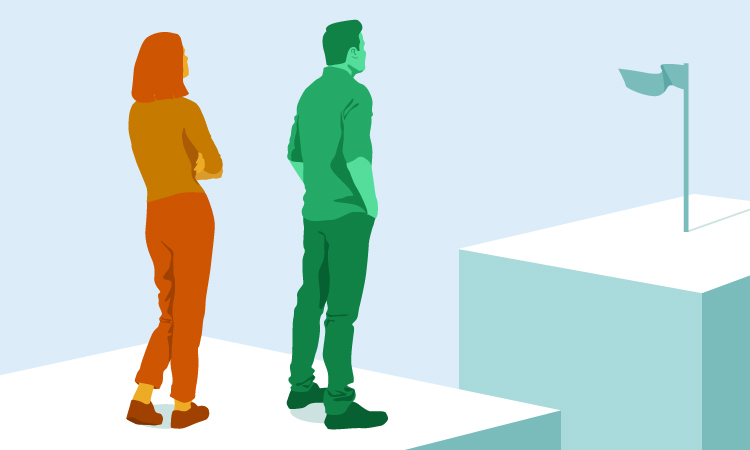


Steve Jobs, rightly said “Design is not just what it looks like and feels like. Design is how it works” and to make things work effectively there are some very interesting processes in place. Hurrying through these processes comes at a price that is almost never affordable. Of course there are budget constraints and time restrictions but skipping steps in order to achieve an outcome that is “decent” can cost us more money and time as the same is spent again on redoing most of it at a later stage.
So, Let’s talk about one of the most important & interesting processes in designing any product – Discovery Workshop.
Discovery workshops are the stepping stones that provide comprehensive understanding of a product & these workshops help in collaboration between teams to help collect information required to begin a project.


Molly wanted Irene to make a good Hat. Molly didn’t tell Irene much about this. What’s the occasion? What’s the budget? What material and color? Should it have any special decorative items? Nothing.
Molly only asked Irene to make it as soon as possible and to ask her any doubts should she have them. Irene asked Molly for a meeting but she stated that she was too busy and wanted Irene to start immediately. So Irene went ahead and started drawing the hat. 1 or 2 sketches were quickly shown to Molly out of which she chose one and then Irene directly shifted to producing the hat. Within 5 days the hat was ready. Irene shows it to Molly.
Molly gasped “What is this? How can I wear that hat to my best friend’s wedding?” she said.
“It doesn’t even match my outfit. I wished you would’ve added feathers on the hat to make it stand out a bit at least.”
“What can we do now?”
Both Molly and Irene were depressed and annoyed. Molly expected better from Irene. Irene wished Molly had given her the clear picture.
Later that day, since Irene had promised Molly to make a fine hat she listed down some questions whose answers would help make one.
With these questions in hand, Molly and Irene had a phone call where they discussed them in detail. Post which, Irene sketched 1 hat and took a soft approval from Molly before jumping into production. Irene even added a small, concealed zip pouch in her hat for carrying some money and the feathers along with a small bow accentuated her entire look. The drawing was enough for both of them to visualise the final product with which Molly was ecstatic. She was appreciated at her friend’s wedding and received many compliments. And Irene got more hat inquiries then after.
Molly came to Irene with a requirement of making her a hat, just as a client comes to an agency/designer for building an application. Molly, just like most clients, was pressed for time and anxious that the product won’t be delivered. Thus, tries to rush and skip steps, like doing a quick phone call or a meeting or in case of a client, doing a discovery workshop.
Irene, like the agency, had a very different vision on how the product would look. They don’t share the same end goal only because it was not discussed to its full extent. Investment of resources, time and money was made. The product was created and not well received. Thus the return on investment was low and inacceptable. The discussions followed after are mainly due to disappointments and lack of communication. Not because Irene wasn’t talented. Or because Molly didn’t know what she wanted.
The target user, occasion/need, budget, risk management etc. are discussed at length in order to come to a common ground and envision the same outcome to avoid disasters. This is what a discovery workshop covers.
The investment of time = money is made and post that, the product created was well appreciated and in tandem with the requirements and the end goal of all those involved. Thus ROI is high on the basis of profits, user experience and overall acceptability.

Stakeholders come with a certain vision and passion that is based on a problem they have discovered. Designers on the other hand are being handed a solution option which they have to tweak and make better.
A discovery workshop helps align these two parameters so as to have a somewhat clear understanding of how the end result should be. It is easier to work towards that goal & product vision when discussing it with every team member who is working on to achieve it.

Resources = time = money. When you skip the discovery workshop and jump to user flows and wireframes, huge amounts of discussions, back and forth and iterations start happening on the design directly. The designers take time to understand what is expected from them which in turn means a lot of time wasted and frustrations leading to disappointments.
The discovery workshops help set the tone of the coming weeks. It helps set a timeline based on requirements that’ll make the application worth the launch. It helps to set small goals that work toward the bigger picture which is shared by not only the stakeholders but also the designers.

A poor outcome or the risk of it is much more scary than monetary loss. It can shake the faith of initiating something let alone losing the money and time spent to make it. Avoiding the discovery workshop means risking the possibility of poor outcomes or a result that the stakeholders and designers aren’t happy with. This happens as all the vital information of the project is in the mind of each individual. Nothing is shared thus nothing is prioritised. Due to this gap, every person on the project is achieving a differently assumed goal rather than a common one. No expectations are fully met and disappointments are everywhere. A discovery workshop can facilitate meeting expectations and creating something that step by step, everyone has envisioned.
Sharing the same page while creating something (product or service) is more important than one can imagine.

The module that you thought will take 2 days, took 2 weeks to complete as it ended up being critical and not much time was allocated for it. Or an important feature you were banking on actually confuses the user and disrupts the experience thus you need to make changes to the flow. These and the likes of them add costs and time and confuses the designers and the stakeholders of what the outcome will actually be.
These hiccups are absolutely avoidable by planning well in advance during a discovery workshop. The budgets, delivery roadmap and a counter strategy for challenges that may arise are all taken care of during the workshop.

When in a room, designers and stakeholders start discussing the project at its nascent stage, many ideas are excitedly thrown around. New features or possibilities pop out and the vision with which the project began becomes everyone’s vision, a shared goal.
Skipping the discovery phase or the Jam session, as some call it, can strip the project of exploring possibilities. Discovery workshops thus help maximise the value and that in turn reflects in the outcome and in the fool-proof experience which the users can enjoy.

When you begin with a project it feels as though almost everything is important. But lack of time and money makes it difficult to prioritize what to give more importance. The designers may end up spending a lot more time and effort on something that doesn’t need much attention and then in the end will have to rush with things of prime importance. During the discovery phase, you can create a prioritized list of most important tasks to be achieved.
Or in case start-ups will call it MVPs. This allows everyone to give dedicated time and resources to essential deliverables and plan it efficiently.
The discovery phase is important for understanding the goals and requirements of any new startup, business process, product, or services. Even if clients are pressed for time, for the sake of the quality of the project’s output, discovery workshops should never be eliminated from the process. One can find and learn of many ways to design shorter workshops that yield high amounts of information and help create better applications and experiences.j
